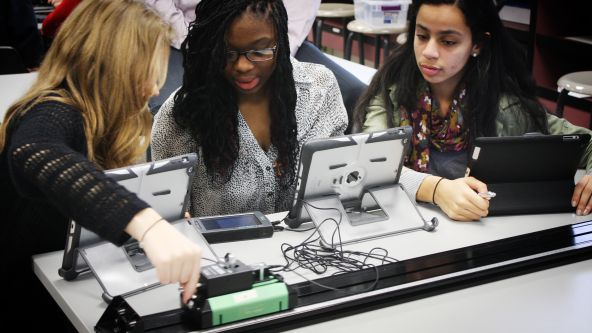Educational technology can transform the teaching and learning process. This is especially true in STEM classrooms where software and some cool, hands-on hardware tools can engage students in scientific discovery.
When educators have students explore scientific practices and procedures, they are tapping into a key goal of science instruction and an important means to help students build their scientific understanding. There are some pretty cool scientific technologies available for the classroom today, a lot of which are in the form of probeware, such as a wireless temperature probe, an accelerometer, an emissions spectrometer and more, that, when connected to a computer or to a mobile data-collection device, are used to help students analysis findings and think critically about scientific concepts. For students, understanding how to use technology to collect data, analyze data, and then draw conclusions based on the evidence are important practices detailed in Next Generation Science Standards (NGSS), and just might lead to a future STEM career.
A best practice example of how probeware can be used effectively can be seen in Jennifer Cournia’s honors physics class at Jesuit High School in Portland, OR. The school initially investigated ways to use technology to engage students across the curriculum and to introduce personalized learning at a low cost. After evaluating the available technologies, Cournia chose Vernier Software & Technology’s Connected Science System® for use in her class. The Connected Science System is a networked collection of technology – encompassing Graphical Analysis for iPad app, Vernier Data Share web app, and LabQuest Viewer software – that expands the ability to use data collected with Vernier’s LabQuest 2 data-collection device to support hands-on, collaborative learning.
Using LabQuest 2 and the school’s existing sensors, each lab group in Cournia’s class was able to work together on an experiment while wirelessly streaming data to the Graphical Analysis for iPad app. In one particular investigation, “Newton’s Second Law,” students mounted two sensors – the Low-g Accelerometer and Dual-Range Force Sensor – to a Vernier Dynamics cart. As students pushed and pulled the cart on the track, the force applied and the resulting acceleration data were recorded. The data were wirelessly streamed over the school’s Wi-Fi network from LabQuest 2 to the Graphical Analysis app, where they individually completed their analysis.
During the lab, students investigated the force vs. time and acceleration vs. time graphs in Graphical Analysis and immediately noticed a relationship: data points with a large positive force also had a large positive acceleration. A large negative force yielded a large negative acceleration. To investigate the relationship between force and acceleration, students made predictions about the shape of a force vs. acceleration graph. Next, each student set up the axes of that graph in Graphical Analysis and applied a linear fit. Students discovered that the slope, or force per acceleration, corresponded to the combined mass of the cart and sensors. To finish up the lab, students used the export function in Graphical Analysis to submit their graphs to a course management app, where Cournia had the tools to review, grade, and comment on students’ work.
As students’ comfort with using the iPad and lab equipment grows, Cournia hopes to gather increasingly valuable insights on student understanding. Students will annotate their graphs, combine it with their lab reports in Pages®, and submit it instantly for assessment. Cournia will be able to gauge student understanding, as it develops, and adjust her instruction accordingly.
In Cournia’s class, as well as STEM classrooms across the world, the combination of mobile technology with LabQuest 2 and Vernier probeware provides new opportunities for student engagement. Such technologies also have the power to not only increase student outcomes, but foster a deeper understanding of science concepts and an ongoing interest in STEM education.
To learn more about the value of probeware, visithttp://www.vernier.com/forms/whitepaper/ .











